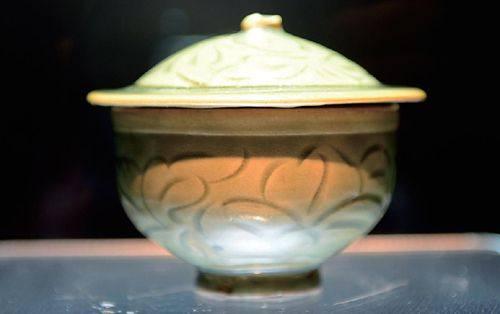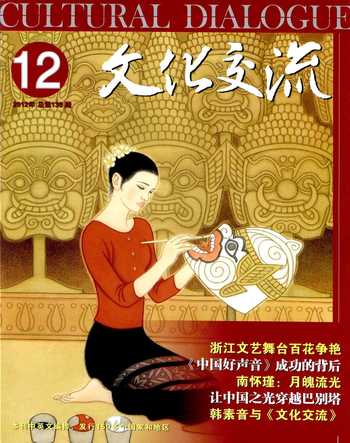庙堂与市井:“宋金瓷话”展
易紫仙



2012年之秋,杭州南宋官窑博物馆迎来了“弱冠之礼”—一场名为“宋金瓷话”的五馆瓷器精品展。二十曰弱冠,弱冠及笄,翩翩之岁。来自大江南北的窑址博物馆前来贺喜,拿出了各自的镇馆之宝:越窑瓷碗的千峰翠色,龙泉瓷瓶的委婉风姿,耀州瓷尊的重峦叠嶂,磁州瓷枕的翰墨黑白,至于那南宋御用之各色瓷器,道尽朱墙春色、宫苑雪月……
秋雨绵绵,撩人寻思,撩人阅读:笔者去赴这场穿越900年的艺术小宴。
这次“宋金瓷话”展,突出“生活”二字。因在彼时,制瓷业引来社会繁胜,瓷器已不再是王孙贵胄的专享,也非只是阳春白雪,它们已慢慢融入百姓的生活常态中。因此,这段青白流韵的历史不仅在宫廷与华堂间,也在坊巷与陋室间展开。
历史常常在某一个节点上十分相似。遥想宋金瓷器的发展,再对比其后在欧洲的销售与变异,我们会发现,不论是在中国还是西方,瓷器的盛行总是始于精英阶层,兴于下里巴人,终为所有阶层的人所使用和欣赏。
汉唐尚武功,两宋重文治。宋代历朝皇帝对文化皆极为重视,在社会上形成了一个庞大的文化阶层,这对艺术的发展大为有利。政和年间,徽宗因不满当时进贡御用瓷器的瑕疵,遂引入汝瓷及开封东窑等窑口窑系的制造精髓,在东京汴梁照自己的设计、亲自指挥烧制巅峰之瓷。自此之后,官窑得以发展壮大。南宋虽偏安一隅,但在江南繁华之地,百业兴旺,歌舞升平。官博展出了一系列南宋官窑青瓷花瓶与焚香炉。可以想象,当年秋风瑟瑟,高宗拾级明月楼,一弯冷月,让青瓷尊式熏炉的沉香勾起心底沉思;抑或白雪漫天,插一枝红梅于青瓷玉壶瓶,对花清供。瓷器,仍是王孙追求艺术不可或缺之物。
瓷器刚传至欧洲时,因其稀有和浑然天成,被视作超然的圣物。15世纪后半期,意大利画家安德雷亚·曼泰尼亚所绘的《东方三贤朝圣》中,最年长的贤者将一盏盛满黄金的中国青花有盖茶盅献予圣婴耶稣和圣母,这里的青花瓷的神圣寓意不言自明。1514年,文艺复兴威尼斯画派画家贝里尼的《众神聚宴》,描绘了古罗马众神于林泉间聚宴畅饮之景,其中有三只装盛物的瓷钵描绘于突出位置。据专家考证,“这三只瓷钵的形体与风格、花纹都表明,确为明朝宣德成化年间之物”。画中的瓷器是供诸神享用的圣器,而非凡物。
由此可见,瓷的虚静沉稳、透明纯净,不仅成就了中国宫闱中的分外雅致,还契合了西方文化中至纯至善而圣的寓意。但若将瓷仅限于这个物外超然,那就狭隘了。毕竟,它由土而成,是普遍的存在。
宋金时期瓷器制造业的兴盛与普及,源于当时商品经济的蓬勃发展。《东京梦华录》《都城纪胜》等描写汴梁和临安都市经济的著作中,皆有描述两宋全国工商业活动的各种细节。城镇解放,商贾云集,“人口浩穰……所谓花阵酒池,香山药海,别有幽坊小巷,燕馆歌楼,举以万数”。宋人爱饮茶、斗茶,金人好饮酒。酒肆茶坊多如牛毛。“谁怜九里松间路,犹有人间市井喧。”在南宋临安,就连幽静的九里松,都有茶酒喧嚣。而或高雅或粗犷的瓷器给茶酒之风增加许多情趣。这次展出中,北宋耀州窑的青釉刻花花口尊,为酒器,如雨后荷叶羞展,青葱嫩绿,工艺和技法十分精湛。而坊间的茶具酒器,虽简单粗制了些,却多了一分恣意随性。同是耀州窑,用金代的青釉素面小碗喝酒,或用黑白釉茶盏吃茶,不乏率真。金秋携友赏月,月白釉的执壶配上青釉印花菊纹碗,实乃赏心乐事。
在这次展览上,笔者觉得瓷瓶为最多,尤是梅瓶,比如白底黑花的磁州窑栀子花纹梅瓶、青釉缠枝的耀州窑刻花牡丹花纹梅瓶、青瓷的折肩瓶。这当然是因为宋代人爱瓶花,不仅士人爱,平民也爱。《西湖老人繁胜录》有记:“(端午)初一日,城内外家家供养……虽小家无花瓶者,用小坛也插一瓶花供养,盖乡土风俗如此。”因“钱塘有百万人家,一家买一百钱花”,卖花者一早获一万钱也非稀奇事。瓷瓶有贵重的,也有在当时不那么贵重的,像宋代耀州窑黑釉花瓶,无瓶者用瓷坛也可以代之。不管这瓷质容器如何,都不能阻挡平民插花的乐趣,这瓶花之乐,可是真正的众乐乐。
而在西方,随着远东航路的开通,中国瓷器的大量外销,16世纪后期,大西洋沿岸国家的人民已不再将瓷器当做圣物。据传,1562年,参加特伦托会议的布拉加主教兼葡萄牙大使巴托马蒂雷斯接受教皇庇护四世宴请。巴托马蒂雷斯从教皇使用的大量银制器皿联想到教会周遭无数的饥贫信徒,于心不安,遂向教皇进言:中国瓷器雅于银器,虽易碎,但价格较低,望其将银器换为瓷器。除了外观与价格优势外,瓷器对欧洲人而言还有一个妙处。17世纪以前,欧洲常暴发瘟疫,其中一个原因便是劣质的储存容器和餐具:因天气多变,食物混杂串味,容易霉变。而瓷器气孔少、防水密封,有利于食物的储存并保证其卫生,瓷器在欧洲大量普及后,从一定程度上有助于欧洲人的健康。这说明,瓷器已不再是高置于神龛上的圣物,而成为世俗生活的一部分。
瓷器在中外,最终接了地气,但却不会沦为俗类。它普及民间,可以是一个放菜的罐子、盛满荤酒的碗、随意插花的瓶子,使用价值得到最大限度发挥,但艺术价值不会因其冲破精英主义的藩篱而消解。它仍然是文人骚客表现情怀的载体,是尊贵气节,也是一盏青灯、一杯淡茶、一方青砚、一瓶寒梅、一卷好书的宁静悠远。法国文学家雨果曾在一首诗中描述中国瓷器:“在釉彩鲜艳的陶瓷中,绘着天真的象征。”即使瓷已经不再是稀奇物件,但它仍是欧洲人眼中浑然天成、返璞归真的象征。
宋金瓷话,道的是庙堂的高远,却也述了市井的繁华。有华有实,也许正是瓷器的魅力所在。
(本文摄影:李?忠)
Anniversary Exhibition Tells China Story in Ancient Dynasties
By Yi Zixian
The Southern Song Imperial Kiln Museum is celebrating its 20th anniversary in the autumn, 2012 by holding an exhibition of chinaware of the Song Dynasty and Jin Dynasty in conjuncture with four other museums. The other four museums are closely associated with sites of ancient kilns: Yue Kiln, Longquan Kiln, Yaozhou Kiln and Cizhou Kiln. The exhibits combine to feature the everyday-life chinaware of the Song Dynasty (960-1279) and the Jin Dynasty (1115-1234). The exhibition started on October 27 and will go through January 20, 2013.
Ninety percent of the 200 exhibits are archaeological finds and 20 of them are first-grade national cultural relics.
The exhibition aims to feature how chinaware played a part in life, for during the historical period the porcelain utensils were no longer exclusively used by royal houses. They had trickled down to the lower social strata. Porcelain utensils were widely used in everyday life by ordinary people.
Historical periods often resemble each other in terms of chinaware development. Chinaware became popular with ordinary people during the Song and the Jin dynasties. In Europe, royal houses and nobles were the first users and then chinaware began to play a part in the life of ordinary people. In both China and Europe, chinaware experienced this transition in its use.
The highly cultured emperors of the Song Dynasty promoted culture. Dissatisfied with the blemishes of the chinaware tributes, Emperor Huizong designed and oversaw chinaware production in the capital of the Northern Song Dynasty. The Imperial Kiln came into being and made its finest reputation. Contented with the peace in the south, the Southern Song Dynasty saw the booming of chinaware production. A series of celadon vases and incense burners on display at the exhibition indicate that the chinaware was still an art pursuit of the royal house during the Southern Song Dynasty.
In Europe, chinaware was first regarded as something noble and sacred. In “The Adoration of the Konige” by Andrea Mantegna (ca.1431-1506), we see a blue-white porcelain cup filled with gold. In “The Feast of Gods” by Giovanni Bellini in 1514, we see three large porcelain bowls in conspicuous places. Some experts point out that the shape, style and pattern of the three bowls are surely chinaware produced in China in the years of Emperor Xuande of the Ming Dynasty (1368-1644). Scholars may argue about the origin of these chinaware pieces, but it is evident that these chinaware objects in the two paintings are sacred utensils, not something used in the everyday life of ordinary people.
The widespread use of chinaware during the Song and the Jin dynasties is attributed to the booming economy. The utensils for wine drinking and tea sipping on the display at the exhibition tell the story of the prevalent teahouses and wine shops.
The flower vases on the display indicate that it was a fashion of the Song Dynasty to have flowers at home. It is said that scholars and ordinary people of the Southern Song Dynasty loved to have flowers arranged in vases at home. Flowers and vases were a precious part of their daily lives and they spent money on both flowers and vases.
As ocean-shipping routes between Europe and the Far East opened up, large numbers of porcelain utensils manufactured in China were able to make their way to Europe. In the late 1700s, chinaware was no longer regarded as sacred in European countries along the coast of the Atlantic Ocean. The widespread use of chinaware in Europe is said to have helped reduce plagues there. Comparatively, porcelain utensils are better food containers, in which food is less likely to go bad.
As exhibits indicate, porcelain has never lost its noble touch even though a specific utensil may be used as a jar for pickled vegetable, a bowl for coarse wine, a vase for flowers. The story these exhibits combine to tell is about the noble and the common, the artistic and the pragmatic.

